There was once a time where every year there was at least one big photo show where camera and lens makers would set up elaborate booths and roll out their latest and greatest new products, showing them off to dealers and the general public evoking an early form of “pre-internet-GAS”. Shows like the Master Photo Dealers and Finishers Association and Photokina were international affairs that attracted the attention of the whole world, but there were also a great deal of regional shows in places like Tokyo, Leipzig, and New York.
If you were not able to attend one of these shows, your best way to learn about new products was to wait for one of your favorite magazines to review the show and share some of what was announced there. Although each magazine did their best to get this information out as quickly as possible, in those days, it took a month or two before anything would hit the news stands.
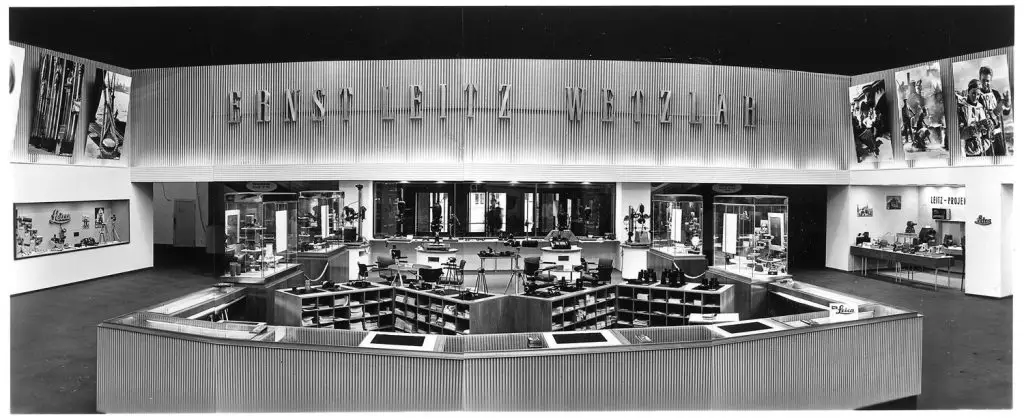
Photo shows happened every year, and if you went year after year, you probably saw a lot of the same stuff, much like today’s auto shows where the same car companies show off their same products with only a spattering of new models for the upcoming year. Some years were more interesting than others, and one of those years was 1959.
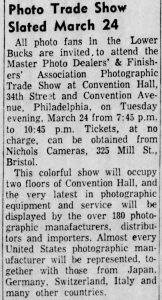
The biggest event in 1959 was the 35th annual Master Photo Dealers and Finishers Association Photographic Trade Show (what a name!) held between March 22-26, 1959 at Philadelphia’s Convention Hall where over 180 manufacturers from all over the world convened to show off their latest and greatest new products.
The entire 1950s was a period of massive change in the world of cameras and lenses. In the years following World War II, color film and photography became the norm for family snapshots with color corrected lenses being sold by nearly every manufacturer. We saw the rise of the Japanese photo industry with companies like Nippon Kogaku (Nikon), Canon, Chiyoda Kogaku (Minolta), Asahi Optical (Pentax) and many others who matched, and in some cases exceeded those from Germany. By the late 1950s, cameras with “electric eyes” became top sellers as they offered a simple form of auto exposure for the novice photographer. Finally, a dramatic shift in popularity from rangefinders to SLR cameras dominated every camera show.
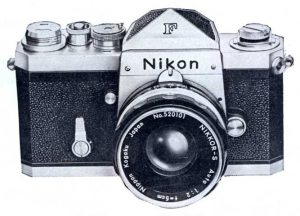
Along with all these changes, the 1959 show featured the American debut of several of the most important cameras ever made. The most obvious of which was Nippon Kogaku’s first reflex camera, the Nikon F. Not to be outdone by their biggest competitor, Canon released their first 35mm SLR, the Canonflex. Other SLRs announced that year were the Minolta SR-2, Petri Penta, Kodak Retina Reflex S, and the medium format Bronica Z. If reflex cameras weren’t your thing, the Canon P, Yashica 35, Konica III M, Olympus Ace, Argus C33, and the rangefinderless Leica M1 all made their debuts.
In this week’s Keppler’s Vault, I bring to you three different wrap ups of the Philadelphia show all from the June 1959 issues of US Camera, Popular Photography, and Modern Photography. Each magazine does a good job presenting some of the most significant cameras, along with short blurbs about other models.
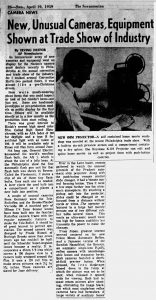
As an extra bonus, I was able to find a short newspaper article from the April 19, 1959 issue of The Scrantonian Sun giving a short summary of the show, mentioning the new Nikon Reflex SLR as one of the show’s highlights.
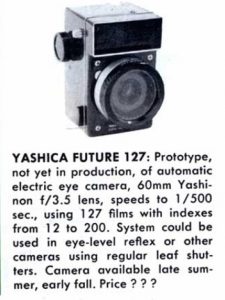
In total, over 50 cameras were announced alongside new lines of projectors, flashes, lenses, and other photo accessories making the 1959 show a sort of “greatest hits” for camera collectors. As with most trade shows, not every product announcement would make it to dealer’s shelves, and this show debuted a never-released prototype called the Yashica Future 127. With an interesting vertically traveling 127 roll film body that looks similar to the 35mm Yashica Rapide and Sequelle. it’s biggest feature was full auto exposure via a large selenium exposure meter on top.
Between the three articles, I like the layout of US Camera’s coverage the best. Although the shortest of the three at only nine pages, it’s nine full pages as opposed to both Modern and Pop Photo’s coverage which start off as full pages and then quickly turn into partial page writeups.
The first article below shows a nice sprinkle of color which gives the article a bit more pop, and also features a good number of larger images of both Nikon and Canon’s SLRs, along with the Miranda C and Widelux panoramic camera.
It starts off accurately describing the show as an onslaught of new models in all segments, from 35mm SLRs to 8mm motion picture cameras. It also gives the most info on the Yashica Future 127 prototype mentioned earlier.
Next is Popular Photography’s coverage which is the only one that has a picture of the show itself. The image spans two pages and although it doesn’t have a great deal of detail, it hints at an exciting and vibrant show that I would have very much liked to have seen. Perhaps if I discover time travel, I will set my DeLorean to March of 1959 and visit it myself!
It’s not part of the actual coverage, but I found it interesting that on the left side of the fourth page of the article is an announcement from Nippon Kogaku about price drops for both the Nikon SP and S3 rangefinders, suggesting they were already all in on their new Nikon Reflex SLR lowering the price on their rangefinders in an effort to steer more people towards their new camera.
Last, but not least is Modern Photography’s coverage which at eleven pages is the longest. It lays out many of the announcements in a sort of buyer’s guide arrangement of squares where each model is covered with a short paragraph of it’s features. Modern’s report is the least visually impressive of the three, but offers the most info, even including a 35mm rangefinder camera with a 45mm f/1.9 lens called the Argon, which before reading this article, I had never heard of.
Both Popular and Modern’s coverage of the shows make brief mention of a couple cameras like the AGFA Ambiflex and Colorflexes and the Zeiss-Ikon Contarex who both made their world-debuts at the previous year’s Photokina, but were also in attendance at the Philadelphia show.
All scans used with permission by Marc Bergman, 2021.

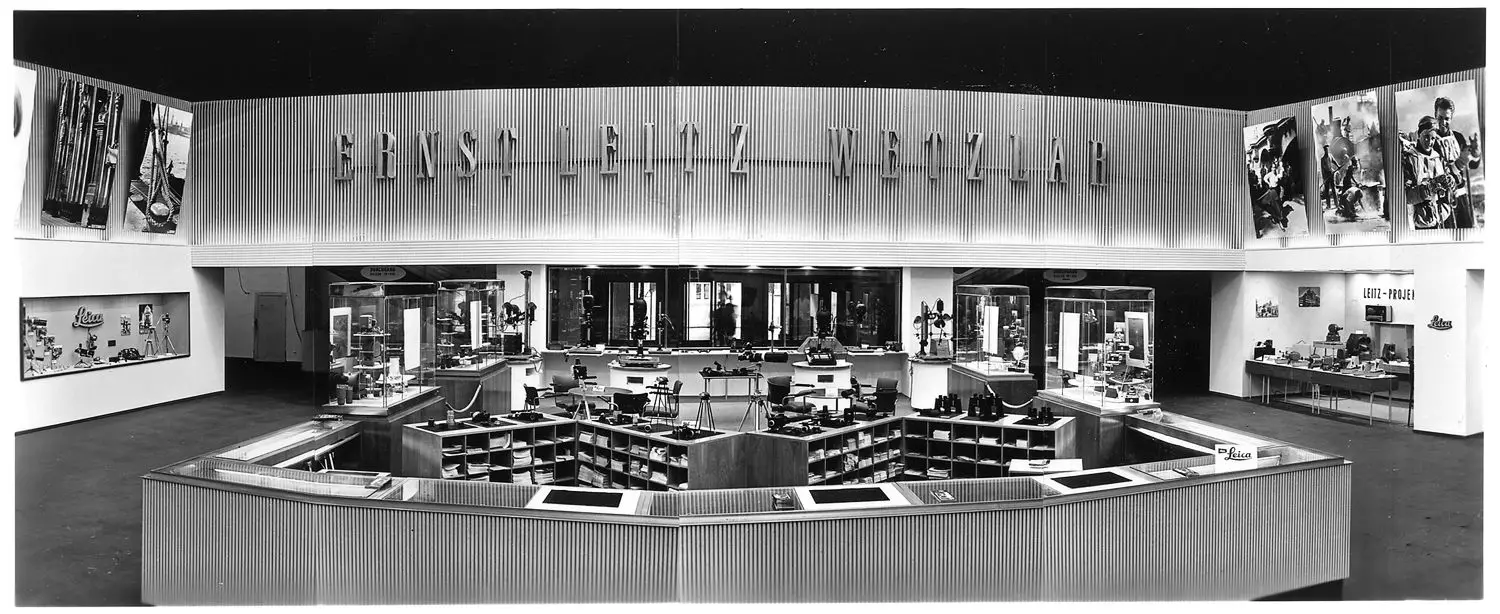
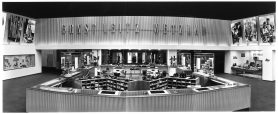
“Hold onto your hats!” Blazing 160 film speed! Lol. We take all of this stuff for granted now.
It definitely puts things into perspective today, especially with digital cameras capable of equivalent ISO speeds of 100,000 and higher! To think that Kodachrome started out as an ASA 10 speed film!
If you “speed demons” would take a look at color print film, you’d be very disappointed that Kodacolor was snailing along at ASA32. Eventually it would creep up to an “astounding” ASA 64, then 80. Fast lenses, tripods, and big flashbulbs might get an image on film, but the action was in slide/transparency film. I suspect that if Fuji Photo Film hadn’t arrived in the U.S. with Fujicolor N100, Eastman Kodak wouldn’t have had the impetus to match it with Kodacolor II and, after Fujicolor 400, make Kodacoclor 400. Now you see why photographers of the time were such “available light” freaks, since ASA 400 was the top speed for Joe Schmoe, photographer. (Acufine Inc. and other “push your black-and-white film to E.I. 1600” were all the rage back then.)
Once upon a time, I saw a “photography of the future” article that guessed at what 21st century photography would be like. Desktop computers and the SmartPhone weren’t even thought of in, say, 1975. Photographic companies were conglomerates, such as “KodIBMMM.” “Large format” was “4X5 cm,” and “Airpods”/Hover tripods kept things steady. I’m not too sure, but the “top pro photographer” asked if Kodachrome was as sharp as rumored, suggesting that it was extinct,which it is today. As for amateur photographers, all they had to do was “press SAVE” to store a potential image in “buffer memory.” By the way, I think it was Herbert Keppler, retired photographer, “writing an article” for “Popular Electrophotography.”
We true geezers recall loading the occasional costly roll of Kodachrome, ASA 10, into our Bolsey B2s to shoot landscapes, back in 1959. When Kodachrome II appeared a couple of years later, it offered ASA 25 – which made quite a difference when you were hand-holding a camera whose lens had a maximum aperture of f3.2.
1959 was about the time I started taking photos at family events using my Dad’s Kodak Duaflex that was converted from a 620 to 120 film spool. The local photo shop made the change for me advising that the 120 film roll film was better. I still have the camera. My Dad also had an Argus C3 which I also kept in my collection of family cameras. David C.